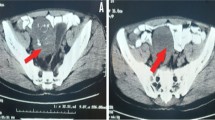Abstract
Persistent Mullerian duct syndrome (PMDS) is a rare form of Disorders of Sexual Development (DSD) characterized by persistence of mullerian structures in a phenotypically and genotypically normal male. The most frequent clinical presentation is that of unilateral or bilateral cryptorchidism. Contrasting opinions exist among clinicians regarding the most suitable surgical intervention in this condition and the potential of fertility later. This study revisits PMDS in terms of varied modes of presentation and the optimum surgical approach to such patients. It, thus, attempts to throw light on the pattern of testicular growth and function within a reasonable follow-up time post-removal of mullerian structures and orchidopexy. The study was conducted in a tertiary health care center in North India. It was a retrospective study carried out by retrieving details of ten patients who had undergone treatment over a span of 9 years (January 2010 to January 2019). The clinical features, family history, surgery undertaken, and follow-up are hereby highlighted along with review of literature. Cryptorchidism was the most common presentation. Orchidopexy with excision of mullerian structures could be done in all except one. Testicular position, volume and vascularity, penile growth, and erection were assessed during subsequent visits at 3, 6, 12, and 24 months. All testes were descended with preserved and normal vascularity. Volumes were in normal range and all experienced good erection. Inference regarding fertility was not possible until conclusion of the study due to ongoing follow-up. Cryptorchidism is the most common presenting feature of PMDS. Familial involvement should be kept in mind. Orchidopexy should be the target surgery. Mullerian structures should be removed ensuring testicular viability. This, when performed carefully, ensures normal testicular maturation. However, long follow-ups will be required for conclusive evidence on fertility.
Similar content being viewed by others
References
Öçal G. Current concepts in disorders of sexual development. J Clin Res Pediatr Endocrinol. 2011;3:105–14.
Manjunath BG, Shenoy VG, Raj P. Persistent müllerian duct syndrome: how to deal with the müllerian duct remnants-a review. Indian J Surg. 2010;72:16–9.
Robboy SJ, Bentley RC, Russell P, Anderson P, Fox H, Wells M. Pathology of abnormal sexual development. Haines and Taylor obstetrical and gynecological pathology. 5th ed. United Kingdom: Churchill Livingstone Elsevier; 2003. p. 1209–32.
Nilson O. Hernia uteri inguinalis beim manne. Acta Chir Scand. 1939;83:231.
Berkmen F. Persistent müllerian duct syndrome with or without transverse testicular ectopia and testis tumours. Br J Urol. 1997;79:122–6.
Renu D, Rao BG, Ranganath K, Namitha. Persistent Mullerian duct syndrome. Indian J Radiol Imaging. 2010;20:72–4.
Sichani MM, Heidapour M, Dadkhah A, Rezavani M. Persistent Mullerian duct syndrome with an irreducible inguinal hernia. Urol J. 2009;6:298–300.
Clarnette TD, Sugita Y, Hutson JM. Genital anomalies in human and animal models reveal the mechanisms and hormones governing testicular descent. Br J Urol. 1997;79:99–112.
Rajesh A, Farooq M. A rare case of male pseudohermaphroditism-persistent mullerian duct syndrome with transverse testicular ectopia – case report and review of literature. Int J Surg Case Rep. 2017;37:72–5.
Odi TO, Abdur-Rahaman LO, Nasir AA. Persistent mullerian duct syndrome: a case report and review of literature. Afr J Pediatric Surg. 2010;7:191–3.
Prakash N, Khurana A, Narula B. Persistent Mullerian duct syndrome. Indian J Pathol Microbiol. 2009;52:546–8.
Kaore A, Kaore B. Persistent Mullerian duct syndrome. NJIRM. 2012;3:153–4.
Thiel DD, Erhard MJ. Uterine adenosarcoma in a boy with persistent müllerian duct syndrome: first reported case. J Pediatr Surg. 2005;40:e29–31.
Romero FR, Fucs M, Castro MG, Garcia CR, Fernandes Rde C, Perez MD, et al. Adenocarcinoma of persistent müllerian duct remnants: case report and differential diagnosis. Urology. 2005;66:194–5.
Shinmura Y, Yokoi T, Tsutsui Y. A case of clear cell adenocarcinoma of the müllerian duct in persistent müllerian duct syndrome: the first reported case. Am J Surg Pathol. 2002;26:1231–4.
Vandersteen DR, Chaumeton AK, Ireland K, Tank ES. Surgical management of persistent Müllerian duct syndrome. Urology. 1997;49:941–5.
Author information
Authors and Affiliations
Contributions
GC, SA, and NS were involved in study conception and design. GC did data acquisition. DB performed the operation and did critical revision. SS and AJ did data analysis and interpretation. GC drafted the manuscript. All authors read and approved the final version of this manuscript.
Corresponding author
Ethics declarations
Conflict of Interest
The authors declare that they have no conflict of interest.
Ethical Approval
All procedures were performed in accordance with the ethical standards of the institutional research committee.
Informed Consent
Informed consent for participation was obtained from parents of all children included in the study.
Additional information
Publisher’s Note
Springer Nature remains neutral with regard to jurisdictional claims in published maps and institutional affiliations.
This article is part of the Topical Collection on Surgery
Rights and permissions
About this article
Cite this article
Chakraborty, G., Acharya, S.K., Sugandhi, N. et al. Does Excision of Mullerian Structures Jeopardize Testicular Growth and Function in Persistent Mullerian Duct Syndrome (PMDS): a Single Center Experience. SN Compr. Clin. Med. 2, 956–960 (2020). https://doi.org/10.1007/s42399-020-00336-7
Accepted:
Published:
Issue Date:
DOI: https://doi.org/10.1007/s42399-020-00336-7




